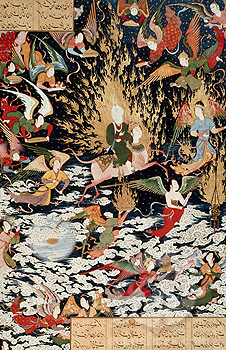
Part One: CHAOSMOS
And so there you are, in a fireman’s coat, hurling through the wee hours across a parched and dusty lakebed in a 1979 American LaFrance firetruck, a pumper from Danville Illinois named Sparky who occasionally spits gobs fire from a flamethrower mounted on the roof of the cab. This is no ordinary Monday night.
Above you the rare shadow of the earth has morphed the full moon into a dusky half-burnt clementine that hangs there pendulous like some wandering orb on the cover of a 70s SF paperback. In the muted moonlight, you can see for once that the thing really is a sphere, and not a disca ping-pong jack-o-lantern arrested midflight. You think upon the old ones and what they must have made of such a vision, so unusual but still predictable to the sharper monkey minds: A call to the gods? An excuse to orgy? Proof that nature is a veil?
“Baby’s on Fire” is spewing out of the iPod, and Fripp’s incandescent solo mixes with Burning Man’s surrounding soundscape of engines, explosions, house beats, and the rising cries of gesticulating passersby who have — wait a sec — just realized that the iconic 40-foot-tall trademark that centers their entire week of organized revelry is prematurely aflame.
Gnat, am I hallucinating?
Of course!
But the Man’s on fire!
Ohshit ohshit. Mhuaahaha! GO GO GO!!!
Later, there will be arguments over motive and ethic, of responsibility and risk and the smoldering coals of living theatre. But for now there is only the Event: the disruptive eruption of novelty, of amoral surprise, of the genuinely untimely. The man is burning! Time is out of joint! Later, there will be News and Analysis and Opinion, those grubby hustlers of thought who monopolize the discourse we use to mirror the world. But for now we, or at least those of us on Sparky, laugh with exultation, with ridiculous wayward joy, because our lives happen, really happen, only in the environs of the Event, in that frothy chaos that dances ahead of the march of facts.
The Event is not history: it arises in a different kind of time, meta-magical time, nonlinear or at least orthogonal to our quotidian grind. The fire that licked the paraffin-soaked figure that Monday night was also the Ouroboros licking its own tail. In a bar after the festival was over the accused perpetrator of the act spoke to my friend about wormholes and time-slips, and it did seem for a moment that we were once again beholding the old school burning men of yore, toxic and raw and stripped of firework finery. And dangerously mythic. As we scrambled off the firetruck, a lanky young fellow with a thin but prophetic beard passed us, calling to all with ears in a stentorian Masterpiece Theatre voice: The Man shall burn when the planets align, and not at the hour appointed by man.
Of course, the planets fall from alignment, and man returns with his watch and his appointments, with his News and Analysis and Opinion. At first the news we heard was indistinguishable from fantasy and projection, not unlike the apocalyptic speculations that greeted the rumors of Katrina during the 2005 festival. The rumors of 2007, however, were all about sabotage, about grappling hooks and decoy fireworks and zip lines and Spider Man-obsessed FX maestros and napalm and ferocious beatings and inside jobs and defense funds and mysterious radio silences.
Gradually, the consensus of facts emerged: At 2:58 a.m., August 28, the Burning Man Festival’s most obvious raison d’être was torched. Not long after, one Paul David Addis, 35, was booked into the Pershing County Jail on felony charges of arson and destruction of property, and misdemeanor charges of possession of fireworks and resisting a public officer. He was subsequently released after some pals paid a bondsman to post his $25,632 bail.
Addis’ early arrest also arrested the more unsettling reverberations of the Event. Once we have a human agent in our sites, the Event becomes a deed, a human deed, and the questions of responsibility and intention arise. Who is this masked man in the mugshot? Why is he smiling? What were his intentions? How could he justify his actions? How shall we judge him?
I am not interested in these questions right now, except for possibly the one about that fucking smile, the gonzo grin of a lost man sailing beyond regrets. What I am interested in are the presuppositions behind our questions, our interrogations really, and how those hidden assumptions bounce back at us as reality.
With this man Addis to speculate about and to blame, the anonymous ambiguity of the Event narrows into the political psychology of a single guy: a loose canon, a channeler of Hunter S. Thompson, an old-school if infrequent Burner. But which guy is it? The fellow who gave Wired a position paper, or the batshit time traveler who met my pal in that bar after the fact, a guy who described the prank as a “birthday candle” and a wormhole? When he torched the man, was Addis acting as a ideologue, or a prankster, or an artist? Each of these actors in turn invokes a different set of criteria we might use to judge the act, its ethical dimensions, its efficacy.
I’ll get to the more conventional and legalistic frameworks for Addis’ dangerous deed next post. But first I’d like to invoke an esoteric one: Poetic Terrorism. The term comes from Hakim Bey, the same fellow who gave us the “Temporary Autonomous Zone,” an underground term that was freely used by participants and observers alike in their quest to tag the events on Black Rock desert back in the day.
In his 1985 pamphlet Chaos: Broadsheets of Ontological Anarchism, Bey writes that “Poetic Terrorism is an act in a Theater of Cruelty which has no stage, no rows of seats, no tickets & no walls.” Bey provides a brief catalog of possible pranks and wonders, which includes one of particular relevance here: unauthorized pyrotechnic displays. Bey has further recommendations:
Don’t do Poetic Terrorism for other artists, do it for people who will not realize (at least for a few moments) that what you have done is art. Avoid recognizable art-categories, avoid politics, don’t stick around to argue, don’t be sentimental; be ruthless, take risks, vandalize only what MUST be defaced, do something children will remember all their livesbut don’t be spontaneous unless the Poetic Terrorist Muse has possessed you.
I don’t know if Addis was possessed by the Poetic Terrorist Muse, or Choronzon, or L’il Abner. For all I know, he was acting from some terrible combination of lust, monomania, and neuro-chemical turbulence. But from some reports he did act as one possessed, possibly spouting prophetic verse. On his flickr page, Danger Ranger (board member Michael Michael) has his Addis photo in a set called “chaos technicians,” which also includes a shot of a guy who has been ejected from the playa five years running. But as my pal Earth pointed out, since when do we expect our poets to be healthy and balanced? You may not agree that his act was poetry, but it was certainly more than the Great Pranknot just a snarky money shot for the camera, but a shuddering, mythic invocation that briefly summoned another age and sluiced a wormhole into the current festival by invoking the contradictions that compose it, by daring the beast to show itself.
At the same time, Addis’ was also, by community as well as legal norms, the destruction of someone else’s art, performed recklessly and on a public enough scale that the “terrorism” in Bey’s phrase is not entirely out of place. Still, I believe that Addis and all who were moved to hilarity and exultation by his acteven if, like me, they wrestle with the contradictions and paradoxes that hilarity and exultation leaves in its wakemust acknowledge that what was vandalized had to be defaced for the poetry, in this most peculiar context, to properly sing. Perhaps you heard the song, or perhaps it sounded like noise, or like some idiot tooting his own horn. Perhaps it stirred something in you you thought had died.
The early burn also reminded me that the best art out there is still the stuff that reveals how the whole show is constructed, not just Black Rock City, or your perception of it, but the whole enchiladayou know, reality. And I’m not just talking about metaphysical, woo-woo, infinite-recursive-loop reality. I’m talking about that more solid fabric of identity, matter, property, image and consciousness that we navigate daily. And sometimes the only way to show how heavily solidified stuff like that is constructed is to destroy it.
Next post: Part Two: The Order of Things




